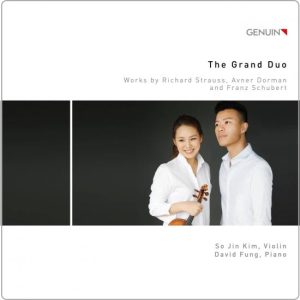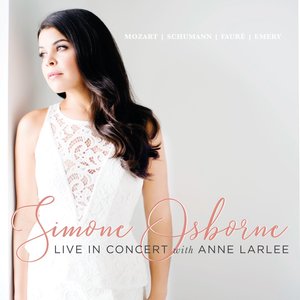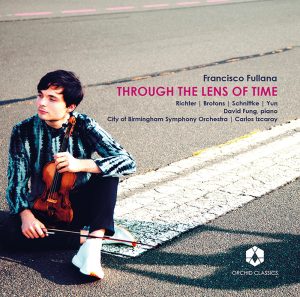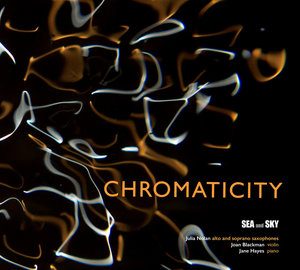
Artist: So Jin Kim, violin & David Fung, piano
The Grand Duo
Label: Genuin
Artist: So Jin Kim & David Fung
Composer: Richard Strauss (1864-1949), Avner Dorman (1975), Franz Schubert (1797-1828)

Artist: So Jin Kim, violin & David Fung, piano
The Grand Duo
Label: Genuin
Artist: So Jin Kim & David Fung
Composer: Richard Strauss (1864-1949), Avner Dorman (1975), Franz Schubert (1797-1828)

Title: Simone Osborne: Live in Concert with Anne Larlee
Performers: Simone Osborne soprano (DMPS’09). Anne Larlee piano
Recording details: Released April 25, 2018
Author: Konoval, Brandon
Publications details: “Is the Essay Dead? Research and Writing Instruction in the Humanities at a Research-Intensive University,” University Higher Education Review 50, no. 2 (spring/summer 2018): 53-85.
Weblink: https://academia.edu
Abstract: The essay is increasingly challenged to justify its relevance and role as a pedagogical tool for introducing undergraduates to research and writing. Genre theory has provided a persuasive basis for an alternative approach that directly engages with academic disciplinarity, in light of which the essay appears to be without a clearly defined place in a modern university curriculum. This case study assesses the use of the essay in a humanities programme of long standing at a prominent research-intensive university, the UBC Arts One programme: these findings suggest that, in concert with a suitable community of practice and targeted enhancements, the essay can effectively prepare first-year students to transition from a gateway programme to upper-level undergraduate studies in a scholarly academic setting.
Author: Roeder, John
Publication details: Presented at the Eastman Theory Colloquium at the Eastman School of Music in Rochester, New York, 30 March 2018.
Weblink: https://www.esm.rochester.edu
Abstract: Growing interest in world-music analysis has highlighted the challenges, long recognized by ethnomusicologists, of comparing music from different cultures on the basis of their divergent indigenous conceptions. Yet, in today’s free-for-all sonic economy, listeners enjoy musics of unfamiliar cultures and histories. What are they hearing? My talk reframes this question in music-theoretical terms: what kinds of insight can a few basic and presumably universal principles of musical listening provide into a ubiquitous musical procedure, “cycling” (persistent repetition)? Most scholars who study musical cycles classify them, or associate them with the general affects they afford, without considering individual examples in much detail. Recently, though, Agawu and Locke have carried out detailed analyses of cyclic West African traditional music in terms of basic percepts. Their approach seems worthwhile to refine and apply to other repertoires.
Of the many different manifestations of cyclicity, I restrict my inquiry to simple textures featuring constantly repeated rhythms, from isolated traditional cultures relatively untouched by colonizing/globalizing influences. My approach concentrates not on rhythmic “objects,” such as fixed metric states or events, but on the dynamic processes through which listeners acquire and continuously revise their sensations of music continuity, articulation, and event categories. Attention to these processes helps move beyond generalities to describe exactly how cyclic pieces differ, and also to recognize common strategies for making the repetition lively or for weaving large-scale processes out of precisely calibrated variations. To expose the basic concepts I first examine some proto-musical chanting of Tibetan Buddhist nuns, then I present analyses and comparison of cyclic music from Haida Gwaii (Canada), Gabon, Bolivia, and Vanuatu. The presentation is intended not only to appreciate the art of these examples, but to advocate for more analytical investigation into traditional sources as a valuable resource for music theory.
Author: Roeder, John
Publication details: Presented at the 2018 Rocky Mountain Music Scholars Conference in Tucson, Arizona, 24 March 2018.
Weblink: https://music.arizona.edu
Abstract: Growing interest in world-music analysis has highlighted the challenges, long recognized by ethnomusicologists, of comparing music from different cultures on the basis of their divergent indigenous conceptions. Yet, in today’s free-for-all sonic economy, listeners enjoy musics of unfamiliar cultures and histories. What are they hearing? My talk reframes this question in music-theoretical terms: what kinds of insight can a few basic and presumably universal principles of musical listening provide into a ubiquitous musical procedure, “cycling” (persistent repetition)? Most scholars who study musical cycles classify them, or associate them with the general affects they afford, without considering individual examples in much detail. Recently, though, Agawu and Locke have carried out detailed analyses of cyclic West African traditional music in terms of basic percepts. Their approach seems worthwhile to refine and apply to other repertoires.
Of the many different manifestations of cyclicity, I restrict my inquiry to simple textures featuring constantly repeated rhythms, from isolated traditional cultures relatively untouched by colonizing/globalizing influences. My approach concentrates not on rhythmic “objects,” such as fixed metric states or events, but on the dynamic processes through which listeners acquire and continuously revise their sensations of music continuity, articulation, and event categories. Attention to these processes helps move beyond generalities to describe exactly how cyclic pieces differ, and also to recognize common strategies for making the repetition lively or for weaving large-scale processes out of precisely calibrated variations. To expose the basic concepts I first examine some proto-musical chanting of Tibetan Buddhist nuns, then I present analyses and comparison of cyclic music from Haida Gwaii (Canada), Gabon, Bolivia, and Vanuatu. The presentation is intended not only to appreciate the art of these examples, but to advocate for more analytical investigation into traditional sources as a valuable resource for music theory.
Author: Metzer, David
Publication details: Presented at South By Southwest (SXSW) in Austin, Texas, 17 March 2018.
Weblink: https://schedule.sxsw.com
Abstract: Ballads tell us much about how feelings are understood and experienced in popular culture at particular moments. In my book The Ballad in American Popular Music: From Elvis to Beyoncé, a larger historical development emerges: a desire to experience feelings in bigger and bolder ways. Important songs and repertoires in this emotional crescendo include Johnnie Ray’s “Cry,” 1960s soul ballads, and the power ballad. Since the 1970s, power ballads have taken this desire to euphoric, giddy heights.

Artist: Francisco Fullana, violin and David Fung, piano | Through the Lens of Time
City of Birmingham Symphony Orchestra
Carlos Izcaray, conductor
Release Date: March 2nd 2018
Orchid Classics: ORC100080
Author: Roeder, John
Article: Music Theory Spectrum 40, no. 1 (Spring 2018): 154–159.
Weblink: https://academic.oup.com
Abstract: The author aims not only to scrutinize the continent’s rich musical practices, but also to confound entrenched prejudices and to promote a deeper appreciation of its musicians’ creativity and expression. While he takes measure of African imagination partly in its “astonishing diversity”(3)—a quality that could be attributed to any collection drawn from a wide enough geographical area—he also provides ample evidence for the characteristics cited above: coherence, rationality, principle, abstraction, and distinctive routines. Accordingly, he allies himself with scholars who sense a “connectedness” at a “background level” evident when we “listen beyond surfaces to the shared structures that prop up those surfaces”(3). All these features “set African music apart from other world music”(307), a claim that he intends as “an expression of desire, an article of faith, and a mark of pride”(18) that will inspire African scholars and …

Ensemble: Sea and Sky
Performers: Julia Nolan alto and soprano saxophones, Joan Blackman violin, Jane Hayes piano
Recording details: Afterday Audio, March 2 2018
Featured compositions:
Walk Safely Over Soft Places (2013) by Matthew Emery
Anne-uity No. I (1993) by Fred Stride
Author: Acuña, Maria Virginia.
Publication details: “Love Conquers All: Cupid, Philip V, and the Allegorical Zarzuela during the War of the Spanish Succession (1701–16).” Eighteenth Century Music 15, no. 1 (2018): 29-45.
Weblink: https://www.cambridge.org
Abstract: An unprecedented shift in the portrayal of Cupid took place in the Spanish mythological zarzuela during the years surrounding the War of the Spanish Succession (1701–1714). For the first time ever, Cupid was depicted not as a god of chaste or erotic love, but as a god at war with other deities. And in every work, a female actor-singer, not a male performer, played the fiery but mournful character. In this article I first explore the cultural understanding of Cupid in early eighteenth-century Spain as articulated by Spanish mythographers of the era, and as seen in the earliest representations of Cupid in Spanish theatre. I then investigate the intersection of myth, allegory, war and music theatre in a case study – the zarzuela Las nuevas armas de amor (Love’s New Weapons, 1711) – suggesting that in this work Cupid functioned as an allegorical representation of the Spanish king, and that the deity’s struggles for power mirrored the monarch’s plight during a time of great political instability. Moreover, I argue that the pre-existing local theatrical practice of cross-dressing allowed for the portrayal of a defeated and sobbing Cupid in the zarzuela.